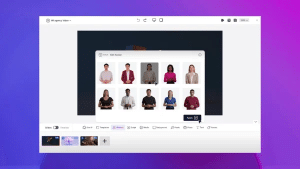Creating genuine connections with audiences online has become increasingly challenging in today’s competitive digital landscape. Whether running a business or building a personal brand, standing out matters more than ever. AI avatars are revolutionizing how we communicate with audiences by making personalized videos accessible to anyone, not just corporations with substantial budgets.
What Are AI Avatar Generators?
AI avatar generators are sophisticated tools that create digital representations of people or characters using artificial intelligence. These platforms transform simple photos or short videos into animated digital versions that can talk, move, and express emotions with remarkable realism.
Unlike traditional avatars requiring extensive manual work, AI avatars utilize neural networks trained on vast datasets of human expressions, movements, and speech patterns. This training enables them to automatically generate appropriate facial expressions and body language that matches their spoken content.
The technology has evolved dramatically. In 2025, AI avatars have moved beyond cartoonish representations to achieve photorealistic quality that often resembles actual video recordings of real people.
Why AI Avatars Are Transforming Digital Communication
Budget-Friendly Production
Traditional video production involves significant costs for camera crews, actors, lighting equipment, and editing teams. AI avatars dramatically reduce these expenses, enabling small businesses and individuals to create professional-looking videos without substantial financial investment.
A single AI avatar video costs significantly less than traditional production while maintaining professional quality. This democratization means small businesses can now produce content that rivals what larger companies create.
Rapid Content Creation
AI avatars provide enormous speed advantages for time-sensitive messaging. Content creators can produce avatar videos in minutes rather than the days or weeks required for traditional video shoots. This velocity enables businesses to respond quickly to market developments and opportunities.
For example, companies can announce new product features on the same day they launch, rather than planning video shoots weeks in advance.
Effortless Scalability
Once an AI avatar is created, it can generate unlimited videos without additional recording sessions. This scalability enables organizations to create different content versions for various audience segments, produce demonstrations for multiple products, develop training materials for different teams, and create content in numerous languages.
For global companies, this means consistent messaging across all markets without multiple filming sessions or different presenters.
Multilingual Capabilities
Modern AI avatars excel at multilingual communication. Leading platforms support over 140 languages and accents, with voice cloning available in dozens of languages. This global reach eliminates language barriers and allows businesses to communicate with worldwide audiences without translation services or multiple presenters.
Explosive Market Growth and Projections
The AI avatar market is experiencing unprecedented expansion. Current market research reveals several key insights:
The global AI Avatar Market reached approximately $9.78 billion in 2025, with projections suggesting it will reach $118.55 billion by 2034. This represents a compound annual growth rate (CAGR) of over 31.9% through the forecast period.
Alternative market analyses project even higher growth, with some estimates suggesting the market could reach $208.61 billion by 2032.
This rapid expansion stems from increased AI technology adoption across industries, growing demand for personalized marketing content, expanding virtual and augmented reality applications, continued growth in remote work and virtual communication, and ongoing improvements in computer graphics and natural language processing.
Gaming and entertainment currently capture nearly 30% of the market share, driven by demand for lifelike interactive characters and virtual influencers. Healthcare applications are emerging rapidly, with AI avatars supporting telemedicine, patient monitoring, and mental health services.
Types of AI Avatar Generators
By Interaction Level
Interactive Avatars: These respond to users in real-time, making them ideal for customer service and interactive experiences. They integrate conversational AI to provide dynamic, engaging interactions.
Non-Interactive Avatars: These deliver pre-written content without real-time interaction. They’re commonly used for marketing videos, presentations, and pre-recorded educational content.
By Deployment Method
Cloud-based Avatars: Operating on remote servers, these platforms offer accessibility from anywhere with internet connectivity. They typically use subscription models and require minimal local computing power.
On-premises Avatars: These run on organizational systems, providing greater control over data and processes but requiring more technical resources for maintenance.
By Visual Style
Realistic Avatars: These aim to replicate human appearance and behavior, often used for professional communications and brand representation. They’re increasingly achieving photorealistic quality that’s difficult to distinguish from real video.
Stylized Avatars: These offer creative interpretations ranging from slightly enhanced to cartoon-like appearances. They’re popular for social media content and entertainment applications.
Leading AI Avatar Platforms in 2025
vidBoard
vidBoard stands out as a comprehensive AI Video Creation Suite featuring over 100 stock avatars and custom avatar creation capabilities. The platform offers industry-leading lip-sync technology with 99.5% accuracy and supports video creation in 125 languages with AI voice cloning.
Key advantages include the most affordable pricing in the market through lifetime deals, making professional AI avatar videos accessible to small entrepreneurs, educators, coaches, and professionals. The platform transforms documents, URLs, or text into engaging videos without requiring editing skills.
Upcoming features include integration with leading text-to-video AI models such as Kling, Veo 3, Runway, and Midjourney. This expansion will provide users with enhanced creative options and cutting-edge AI capabilities.

HeyGen
HeyGen has gained recognition as one of the most user-friendly AI avatar platforms. It offers over 1000+ realistic talking avatars with fast generation times, making it ideal for creators new to avatar technology.
Synthesia
Synthesia provides access to over 230 ready-made AI avatars and enables personal avatar creation in just 5 minutes using webcams or smartphones. Their avatars speak in more than 140 languages and accents, with voice cloning available in 29 languages. The platform’s avatars display emotions that match their speech, creating more engaging content.
D-ID
D-ID specializes in advanced AI avatar generation focused on creating highly realistic digital humans. Their technology excels at animating still images and creating talking head videos from single photographs. The platform leads in interactive digital humans with real-time video creation and multi-language video translation.
Additional Notable Platforms
Rephrase.ai: Offers high-fidelity avatars with precise lip-sync accuracy, brand-tailored appearances, and easy marketing platform integration.
Movio: Excels in e-learning and marketing applications with AI-powered script assistants and extensive template libraries.
BIGVU: Creates ultra-realistic digital twins through demo video recording, supporting 29 languages with adjustable speed and expression stability.
Fotor: Provides a free online AI avatar generator for quick image-to-avatar conversion with various styling options.
Emerging Trends in AI Avatar Design for 2025
The AI avatar landscape is evolving with several distinctive trends :
Hyper-realistic Avatars: Professional applications increasingly favor photorealistic avatars that resemble high-quality photographs rather than stylized representations. These are particularly popular for LinkedIn profiles and virtual business meetings.
Artistic and Stylized Avatars: Creative and social media applications embrace avatars inspired by cyberpunk aesthetics, fantasy themes, or minimalist design approaches.
Metaverse Integration: AI avatars are becoming essential for virtual events, 3D environments, and gaming platforms, featuring full-body avatars that react to user movements and voice commands.
Seasonal and Event-Specific Avatars: Personalized avatars for holidays, life events, and special occasions are gaining popularity for enhanced user engagement.
Professional Branding Elements: Business professionals utilize avatar background removal, studio lighting effects, and formal attire overlays for consistent personal branding across platforms.
Industry Applications and Use Cases
Sales and Marketing
AI avatars serve as dynamic brand ambassadors and content creators, significantly increasing engagement and personalization at scale. vidBoard’s personalized video outreach helps sales teams achieve up to 300% higher response rates compared to traditional cold outreach methods.
Customer Service Excellence
Conversational AI avatars provide visually engaging, human-like support that improves customer experience while enhancing operational efficiency. These virtual assistants handle inquiries, provide support, and guide customers through processes with friendly, human-like presence.
Educational Innovation
AI tutors and virtual lecturers deliver adaptive, personalized lessons with interactive capabilities and real-time Q&A functionality. The Online Learning Consortium highlights how avatars are creating new educational frontiers while addressing important ethical considerations.
Healthcare Applications
AI avatars assist in telemedicine, patient monitoring, mental health support, and preliminary diagnostics with empathetic interaction capabilities. Healthcare represents one of the fastest-growing segments for AI avatar adoption.
Corporate Training and HR
AI avatars conduct onboarding sessions, simulate real-world training scenarios, and provide instant feedback to employees. This application reduces training costs while improving consistency and accessibility.
Retail and Hospitality
Virtual shopping guides and digital tour assistants enhance customer experiences through personalized interactions and recommendations. These applications are particularly effective in e-commerce and hospitality sectors.
Creating Your AI Avatar: Step-by-Step Process
Creating a personalized AI avatar has become increasingly straightforward. Here’s the typical process:
Step 1: Record Demonstration Video
Begin by recording yourself speaking naturally to provide the AI system with examples of facial expressions, movements, and speech patterns. This recording becomes the foundation for your digital representation.
Step 2: Input Content Scripts
Once your avatar is processed (typically taking 6-10 hours), input scripts for your avatar to deliver. Many platforms offer AI-powered writing assistance for content generation and script development.
Step 3: Generate AI Videos
Select your avatar and adjust settings such as speaking speed, expression stability, and language preferences. The system generates videos of your digital representation delivering your script with appropriate facial expressions and movements.
Step 4: Customize and Enhance
Finalize your video by adding captions, background music, logos, overlays, or changing backgrounds to match your brand or communication objectives. Most platforms provide extensive customization options.
Ethical Considerations and Security Measures
As AI avatar technology advances, critical ethical and security considerations have emerged :
Data Privacy Protection
Leading AI avatar companies implement strict data privacy protocols, adhering to GDPR compliance and SOC 2 security standards to protect biometric and personal data. Organizations must address concerns about collecting and storing sensitive information used for personal avatar creation.
Transparency and Disclosure
Ethical AI avatar usage requires clear disclosure when audiences interact with AI-generated content rather than human presenters. This transparency builds trust and prevents deception in digital communications.
Identity Protection and Deepfake Prevention
As avatar technology becomes more realistic, the risk of misuse through unauthorized deepfakes and identity fraud increases. Responsible platforms implement safeguards against unauthorized creation or use of someone’s digital likeness.
Advanced detection systems now include on-device real-time deepfake detection and content verification systems like Microsoft’s Content Credentials initiative.
Fairness and Representation
Developers must ensure avatar systems are trained on diverse datasets to prevent bias and enable representation across different demographics. This includes ongoing bias prevention measures and multidisciplinary ethics oversight.
Future Trends and Technology Evolution
The AI avatar industry continues rapid evolution with several emerging trends :
Enhanced Realism and Interaction
Improvements in rendering technology and AI are creating increasingly realistic avatar appearances and behaviors, gradually closing the “uncanny valley” gap. Future avatars will feature more sophisticated interaction capabilities, including gesture recognition, emotional intelligence, and contextual awareness.
Cross-Platform Compatibility
Avatar systems are becoming more interoperable across different platforms, enabling consistent digital representation across websites, applications, VR/AR experiences, and gaming environments.
Simplified Creation Tools
Technology democratization is producing more user-friendly tools that allow non-technical users to create sophisticated avatars without specialized knowledge. This accessibility is driving broader adoption across industries.
Industry-Specific Specialization
Avatar platforms are developing features tailored to specific industries such as healthcare, education, and retail, with specialized capabilities addressing each sector’s unique requirements.
Getting Started with AI Avatars
Ready to transform your digital communication with AI avatars? Here’s your action plan:
Assess Your Communication Needs: Identify where personalized video content could enhance your marketing, training, or customer service initiatives.
Explore Platform Options: Research leading platforms mentioned above to find solutions that align with your specific requirements and budget constraints.
Start with Free Trials: Most platforms offer trial versions or demo access that let you experiment with the technology before making commitments.
Develop Content Strategy: Plan how AI avatars will integrate into your broader content and communication strategy for maximum impact.
Monitor and Optimize: Track engagement metrics for avatar-generated content and refine your approach based on audience response and performance data.
The Future of Digital Communication
AI avatar generators have evolved from experimental tools to essential communication resources across numerous industries. With the market projected to continue explosive growth through the early 2030s, these technologies will become increasingly integral to digital interactions.
The combination of affordability, scalability, and advancing realism makes AI avatars particularly attractive for businesses seeking to personalize communications while managing costs effectively. Ongoing advances in AI technology promise even more sophisticated capabilities in the coming years.
As this technology matures, maintaining ethical standards and security measures will be crucial for ensuring AI avatars enhance rather than complicate digital communications. Organizations and individuals adopting these technologies should prioritize transparency, consent, and responsible implementation.
The transformative potential of AI avatar technology lies in its ability to make digital communication more human, accessible, and effective, bridging the gap between technological innovation and authentic human connection.
Frequently Asked Questions
Q: How realistic are AI avatars in 2025?
A: AI avatars in 2025 have achieved remarkable realism, with leading platforms producing photorealistic results that are often difficult to distinguish from actual video recordings. The technology has moved far beyond cartoonish representations to achieve professional-quality output suitable for business communications.
Q: What’s the cost difference between AI avatar videos and traditional video production?
A: AI avatar videos cost significantly less than traditional production, often reducing expenses by 80-90%. While traditional videos require camera crews, actors, lighting, and editing teams, AI avatars eliminate most of these costs, making professional video content accessible to small businesses and individuals.
Q: Can AI avatars speak in different languages?
A: Yes, modern AI avatar platforms support extensive multilingual capabilities. Leading platforms like Synthesia support over 140 languages and accents, with voice cloning available in dozens of languages, enabling global communication without translation services.
Q: How long does it take to create an AI avatar?
A: Creating a custom AI avatar typically takes 6-10 hours for processing after recording a demonstration video. However, once created, generating new videos with your avatar takes only minutes, providing significant time savings for ongoing content creation.
Q: What are the main ethical concerns with AI avatars?
A: Key ethical considerations include data privacy protection, transparency about AI usage, preventing unauthorized deepfakes, and ensuring fair representation across demographics. Leading platforms implement strict security measures and ethical guidelines to address these concerns.
























